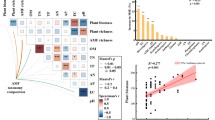Summary
Fumigation of soil with methyl bromide-chloropicrin (2∶1, w/w) killed all detectable infective propagules of endogonaceous fungi in one field and reduced those in another to a trace. However, spore population densities were reduced by only half in the first field and not affected in the second. These effects persisted overwinter in the first field and through the growing season in the second. Apparently spores killed by fumigation do not degrade in soil readily. No evidence was obtained that commercial strawberry transplants were an important source for introduction of endogonaceous fungi.
Similar content being viewed by others
References
Abbott L K, Robson A D and De Boer G 1984 The effect of phosphorus on the formation of hyphae in soil by the vesicular-arbuscular mycorrhizal fungus,Glomus fasciculatum. New Phytol, 97, 437–446.
Alexander M 1965 Most-probable-number method for microbial populations.In Methods of Soil Analysis, Part 2, Chemical and Microbiological Properties. Ed. C A Black. Am. Soc. Agronomy, Madison, Wisconsin. pp. 1467–1472.
Black R and Tinker P B 1979 The development of endomycorrhizal root systems. II. Effect of agronomic factors and soil conditions on the development of vesicular-arbuscular mycorrhizal infection in barley and on the endophyte spore density. New Phytol. 83, 401–413.
Bray R H and Kurtz L T 1945 Determination of total, organic and available forms of phosphorus in soils. Soil Sci. 59, 39–45.
Davis E A, Young J L and Rose S L 1984 Detection of high-phosphorus tolerant VAM-fungi colonizing hops and peppermint. Plant and Soil 81, 29–36.
Gerdemann J W 1968 Vesicular-arbuscular mycorrhizae and plant growth. Ann. Rev. Phytopathol. 6, 397–418.
Gianinazzi-Pearson V, Gianinazzi S and Trouvelot A 1984 Evaluation of the infectivity and effectiveness of indigenous vesicular-arbuscular fungal populations in some agricultural soils in Burgundy. Can. J. Bot. 63, 1521–1524.
Hayman D S and Stovold G E 1979 Spore populations and infectivity of vesicular-arbuscular mycorrhizal fungi in New South Wales. Aus. J. Bot. 27, 227–233.
Helwig J T and Council K A Eds 1979 SAS Users Guide. Statistical Analysis System Institute Inc., Raleigh, North Carolina.
Hildebrand A A 1934 Recent observations on strawberry root rot in the Niagara Peninsula. Can. J. Res. 11, 18–31.
Holevas C D 1966 The effect of vesicular-arbuscular mycorrhiza on the uptake of soil phosphorus by strawberry (Fragaria sp. var. Cambridge Favourite). J. Hortic. Sci. 41, 57–64.
Hughes M, Martin L W and Breen P J 1978 Mycorrhizal influence on the nutrition of strawberries. J. Am. Soc. Hort. Sci. 103, 179–181.
Kiernan J M, Hendrix J W, Stoltz L P and Maronek D M 1984 Characterization of strawberry plants produced by tissue culture and infected with specific mycorrhizal fungi. HortScience 19, 883–885.
Kormanik P P and McGraw A-C 1982 Quantification of vesicular-arbuscular mycorrhizae in plant roots. In Methods and Principles of Mycorrhizal Research. Ed. N C Schenck, American Phytopathological Society, St. Paul, Minnesota. pp 37–45.
Mason D T 1964 A survey of numbers ofEndogone spores in soil cropped with barley, raspberry and strawberry. Hortic. Res. 4, 98–103.
McGraw A-C and Hendrix J W 1984 Host and soil fumigation effects on spore population densities of species of endogonaceous mycorrhizal fungi. Mycologia 76, 122–131.
Menge J A 1982 Effect of soil fumigants and fungicides on vesicular-arbuscular fungi. Phytopathology 72, 1125–1132.
Menge J A, Munnecke D E, Johnson E L V and Carnes D W 1978 Dosage response of the vesicular-arbuscular mycorrhizal fungiGlomus fasciculatus andG. constrictus to methyl bromide. Phytopathology 68, 1368–1372.
Mosse B 1973 Advances in the study of vesicular-arbuscular mycorrhiza. Annu. Rev. Phytopathol. 11, 171–196.
Nemec S 1974 Populations ofEndogone in strawberry fields in relation to root rot infection. Trans. Brit. Mycol. Soc. 62, 45–49.
O'Brien D G and McNaughton E J 1928 The endotrophic mycorrhiza of strawberries and its significance. W. Scotland Agri. Col. Res. Bul. 1, 1–32.
Powell C L 1976 Development of mycorrhizal infections fromEndogone spores and infected root segments. Trans. Brit. Mycol. Soc. 66, 439–445.
Pugh G J F 1980 Strategies in fungal ecology. Trans. Brit. Mycol. Soc. 75, 1–14.
Ridings W H, Schenck N C, Snell R R, Keen W M and Cornell J A 1977 Reinvasion of methyl bromide treated soil by soil-borne fungi and their subsequent effect on citrus seedling growth. Proc. Florida State Hort. Soc. 90, 70–74.
Ruehle J L and Marx D H 1979 Fiber, food, fuel, and fungal symbionts. Science 206, 419–422.
Schenck N C and Smith G S 1981 Distribution and occurrence of vesicular-arbuscular mycorrhizal fungi in Florida agricultural crops. Soil and Crop Sci. Soc. Florida Proc. 40, 171–175.
Schollenberger C J and Simon R H 1945 Determination of exchange capacity and exchangeable bases in soil-ammonium acetate method. Soil Sci. 59, 39–45.
Sokal R R and Rohlf F J 1969 Biometry: the Principles and Practice of Statistics in Biological Research. W H Freeman, San Francisco.
Tommerup I C and Abbott L K 1981 Short communication: prolonged survival and viability of VA mycorrhizal hyphae after root death. Soil Biol. Biochem. 13, 431–433.
Turkington R 1983 Plasticity in growth and patterns of dry matter distribution of two genotypes ofTrifolium repens grown in different environments of neighbours. Can. J. Bot. 61, 2186–2194.
Walker C, Mize C W and McNabb H S Jr 1982 Populations of endogonaceous fungi at two locations in central Iowa. Can. J. Bot. 60, 2518–2529.
Wilhelm S, 1958 Parasitism and pathogenesis of root-disease fungi. In Plant Pathology Problems and Progress. pp. 1908–1958., Ed. C S Holton. University of Wisconsin Press, Madison, pp 356–366.
Wilhelm S and Paulus A O 1980 How soil fumigation benefits the California strawberry industry. Plant Dis. 64, 264–270.
Author information
Authors and Affiliations
Rights and permissions
About this article
Cite this article
McGraw, A.C., Hendrix, J.W. Influence of soil fumigation and source of strawberry plants on population densities of spores and infective propagules of endogonaceous mycorrhizal fungi. Plant Soil 94, 425–434 (1986). https://doi.org/10.1007/BF02374335
Received:
Revised:
Issue Date:
DOI: https://doi.org/10.1007/BF02374335




